Muslim Indians are more likely than the country's Hindus and members of all other religions - including those who don't belong to a religious group - to be "suffering." One-third (32%) of the country's Muslims are suffering. Gallup classifies respondents as "thriving," "struggling," or "suffering" according to how they rate their current and future lives on a ladder scale with steps numbered from 0 to 10 based on the Cantril Self-Anchoring Striving Scale. People who rate their current life situation and their life in five years a "4" or less are considered suffering. Hindus (23%) and members of India's various other religious sects (15%) are less likely to be suffering.
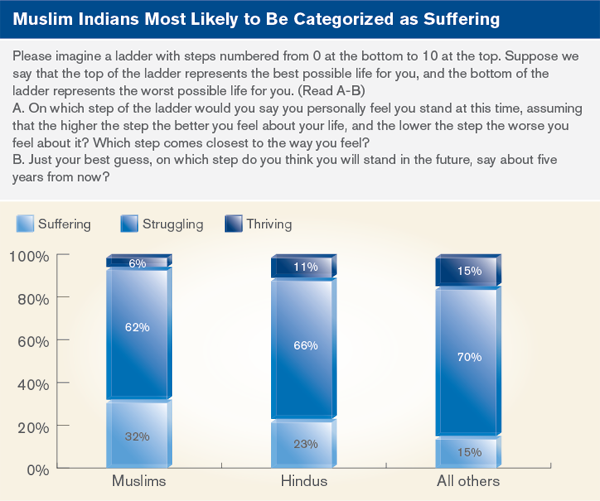
The findings in this report are based on nationally representative studies conducted in 2010 and 2011 with a total of 9,518 Indians, including 1,197 Muslim Indians.
The roughly 1.3 billion people who make India the world's second most populous country live in a diverse land. Hindi is the official state language of the nearly two dozen languages officially recognized, but it is the primary language of less than half of India's residents. The state, secular by mandate of its constitution, offers no official state religion, but 80% of India's population is Hindu.
Muslims represent India's largest religious minority group at nearly 13% of the country's population. In a country with such a large populace, though, that minority translates to more than 140 million residents - meaning India has more Muslims than any other country in the world except for Indonesia and Pakistan. And this minority group is growing. The 2001 census found the Muslim population in India had increased almost 200% in 40 years, from 1961 to 2001. While the rest of the country's populace grew, it did so at a slower rate (134% for all of India during the same four decades, including Muslim Indians). The annual growth rate for the Muslim population during that time was 2.7%, higher than the national average of 2.1%. Gallup data show that Muslims in India are more likely than Hindus and members of other religions to have three or more children under the age of 15 at home.

This growing minority of Muslim Indians are more economically disadvantaged and dissatisfied than Indians of other religious groups. Muslims are more likely than the Indian population overall to live below the poverty line, 31% compared with 26%, according to the National Council of Applied Economic Research in India. Gallup data show that the country's Muslims (51%) are less likely than Hindus (63%) or others (66%) to be satisfied with their standard of living. Similarly, Muslims (65%) are more likely than Hindus (53%) and others (51%) to say their standard of living is staying the same or getting worse.
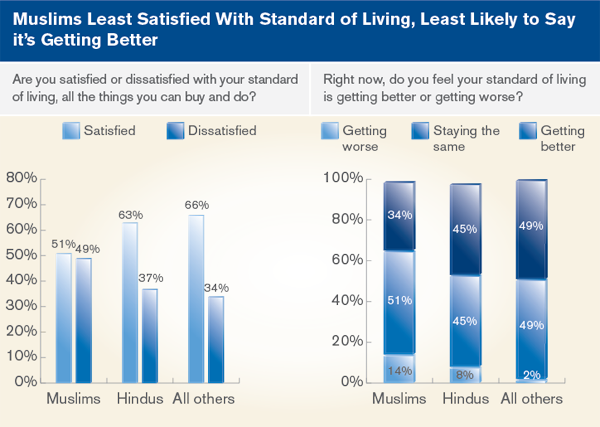
Household income is a particular disadvantage for Muslims in India. Muslims (47%) are more likely to say they find it "difficult" or "very difficult" living on their present household income than Hindus (39%) and members of other religions (24%). Muslims (23%) are also slightly more inclined than Hindus (18%) and others (12%) to say there were times in the past year when they did not have enough money to buy the food that they or their families needed.

Abject poverty is partially to blame for low levels of education among Muslim Indians, according to a 2006 report titled "Social, Economic and Educational Status of Muslim Community of India," chaired by Justice Rajindar Sachar and produced for Indian Prime Minister Manmohan Singh. The report calls education a "grave concern" for the country's Muslim community - not only the lower levels of education received, but the low quality of such education. Educational attainment is not particularly high throughout India, but Muslim Indians (88%) are slightly more likely than Hindus (84%) to list their level of education as elementary or less; all other Indians (72%) are distinctly ahead on this measure.
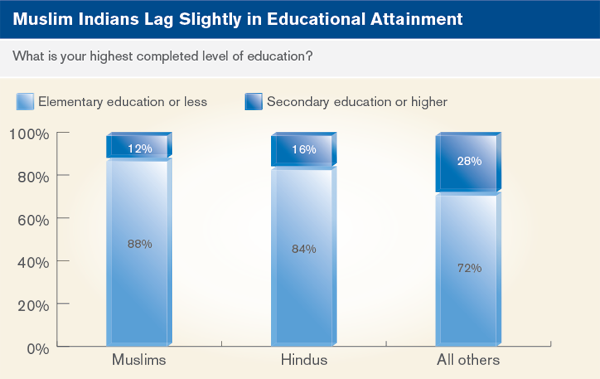
The report cites poor access to schools in predominantly Muslim areas of India, and high pupil-teacher ratios in the schools that are present. But in Gallup's 2011 survey, Muslim Indians (74%) are as satisfied as Hindus (74%) and other Indians (76%) with the educational system or schools in their areas. Indians overall were more satisfied with their local schools in 2011 than in 2010.
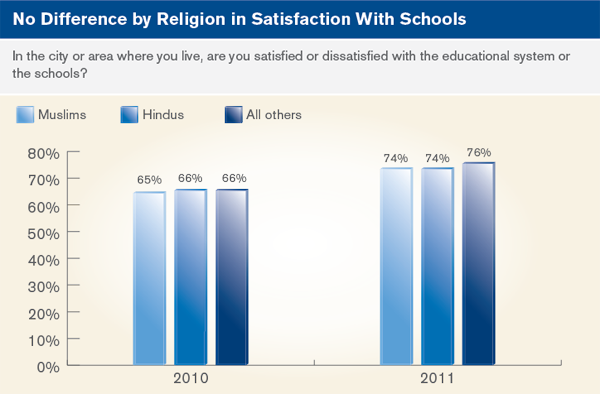
India has implemented nationwide improvements to elementary schools, as outlined in a 2010 District Information System for Education (DISE) report, in the years since the Sachar report. The DISE report details an increase in the number of elementary schools throughout the country, improvements made to school facilities (basic improvements such as drinking water, toilets, and cooking facilities), the decreased number of students per classroom, and more computers to schools. According to the report, enrollment at the primary and upper-primary levels has increased, including an increase in the number of Muslim students enrolled in primary and upper-primary schools.
There is a clear divide, though, in satisfaction with education among urban and rural Muslims and Hindus. Those in urban areas of India (83% of Muslims, 87% of Hindus) are more likely than those in rural parts (68% of Muslims and Hindus) to say they are satisfied with the educational systems or schools in their areas. Indians in urban areas are more likely to have higher levels of education than those in rural areas, regardless of religious affiliation.
Muslim Indians are more likely than the other religious groups to be suffering - that is to be highly negative about their current life situation and their expectations for their life situation in five years. Majorities of Muslims (62%), Hindus (66%), and other Indians (70%) are struggling, giving more middle-of-the-road answers when asked to rate their current life and their life as they anticipate it will be in five years. Those Indians classified at the high end of the life evaluation scale as "thriving" make the smallest group, including 6% of Muslims, 11% of Hindus, and 15% of all others.
Gallup also asks Indians to rate their levels of experience relative to several feelings and emotions one day before they took the survey. Muslim Indians fare worse than Hindus and other Indians in nearly all of these measures.
Muslims (70%) are less likely than Hindus (75%) and other Indians (84%) to say they felt treated with respect during the entire day before the survey. Muslims are also less likely than both groups to say that they felt well-rested, that they smiled or laughed a lot, or that they learned or did something interesting that day.
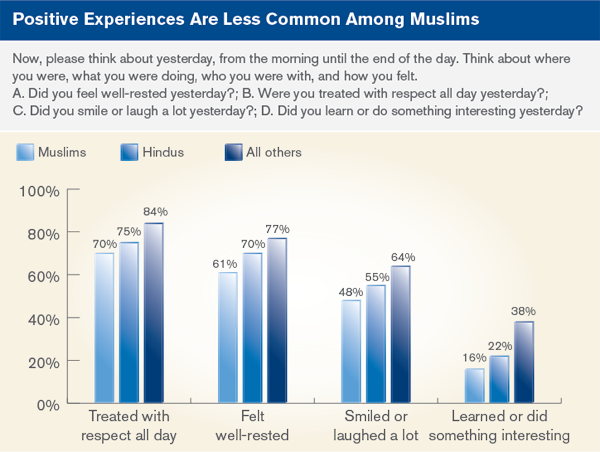
Emotionally, Muslims are less likely than Hindus or other Indians to say they felt happiness and enjoyment during a lot of the day before the survey. Conversely, Muslim Indians are more likely than Hindus to say they experienced stress and worry the day before the survey.
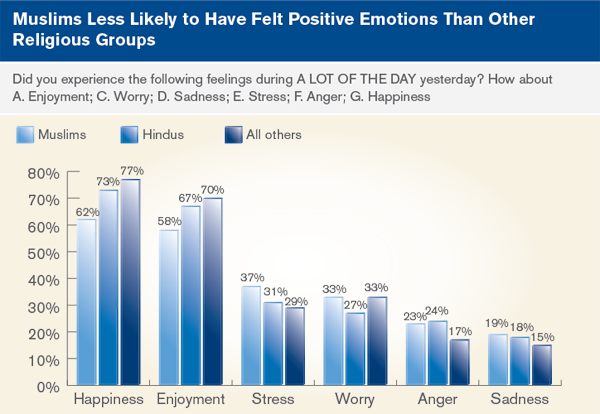
While there are socioeconomic differences that set Muslims apart from Hindus and other religious groups in India, the various factions agree on many topics. Muslims, for example, are as likely as Hindus to say they are satisfied with the freedom they have to do what they want in their lives. They share with Hindus and other Indians a belief in the idea that people in the country can get ahead in life if they work hard. The value Muslims place on opportunity is no less than that of Hindus or other Indians.
Similarities also exist when considering Muslims' opinions about many topics relevant to India's national institutions and identity. India has a carefully built pluralist democracy where no one identity or principle is dominant, and Muslims are as exuberant about the tenets of democracy as Hindus or other Indians. Specifically, Muslim Indians are as likely as Hindus to agree with the principles of freedom of speech, freedom of religion, and freedom of assembly.
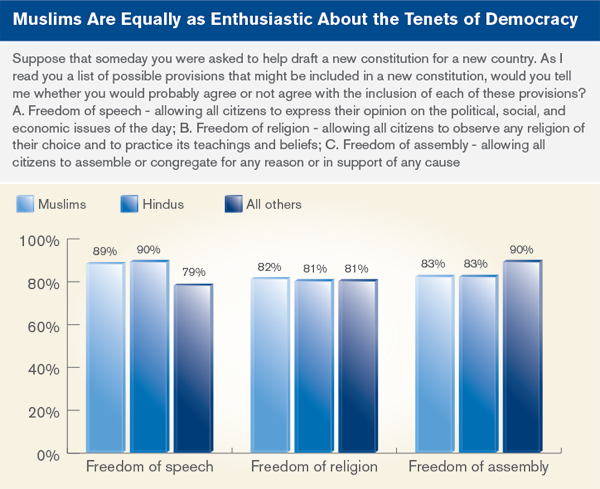
The Sachar report indicates that Muslims struggle against the perception that they are "anti-national," however Gallup data show that Muslims are about as confident in the country's national institutions - save for the judicial system - as any other religious group. Muslims are as likely as Hindus and others to be confident in the nation's military. Muslims and Hindus share similar confidence in the country's financial institutions and in the honesty of the country's elections. While Hindus are more likely than Muslims to be confident in the nation's government, all Indians are equally as likely to say they approve of the job performance of the country's leadership (42% of Muslims, 47% of Hindus, and 39% of all others). Muslims (79%) and Hindus (80%) are equally as likely to perceive corruption in government as being widespread.
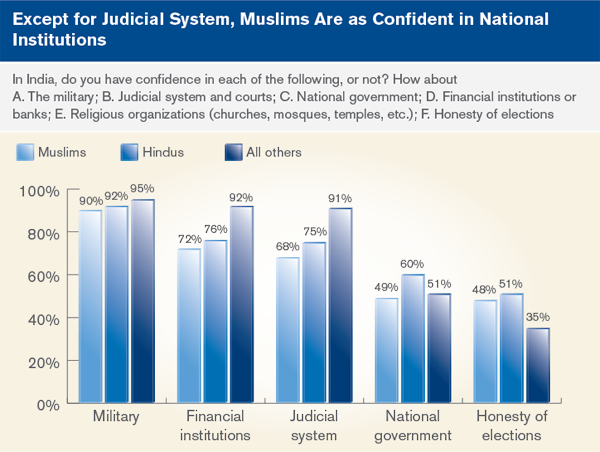
Muslim Indians are less confident than Hindus in the country's judicial system. This could be due to the comparably large percentage of Muslims in Indian jails. In some states, the percentage of Muslims in jail is greater than the percentage of Muslims living in the state. However, confidence in the local police is the same regardless of religion.
Muslims are also as supportive as Hindus and other Indians of women's rights. They are as likely as Hindus and others to agree that residents should have equal access to education, regardless of gender, and that women and men should have equal legal rights. Muslim Indians are also nearly as likely as other Indians to agree that women should be able to hold any job for which they are qualified outside the home - 90% of Indians overall agree this should be the case.
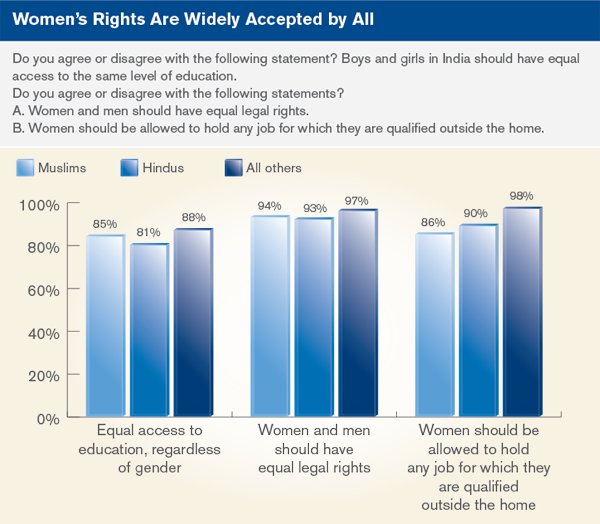
Improving the well-being of Muslims in India begins with changing their educational and economic futures. States throughout the country must take measures to improve the lives and livelihoods of their Muslim populations. Some are already taking steps toward success, typically in the south of India. Some states, though, are far more disadvantaged, such as West Bengal, Bihar, Uttar Pradesh, and Assam.
Improve Muslim educational attainment. Education is essential to lifting a population out of poverty. The country needs an educated workforce to fill the skilled jobs created as India's economy grows. Because Muslim Indians are at an educational disadvantage in a country where achieved levels of education are generally low, it is important states tailor efforts to improve the opportunities and access to education for their Muslim communities. According to the Sachar report, this includes:
-
Creating high-quality, government schools in all areas of Muslim concentrations
-
Opening schools that are exclusively for girls, particularly for grades 9 through 12
-
In co-educational schools, hiring more female teachers
-
Make primary education available in Urdu, as this is the mother language of many Muslims and education in one's native tongue is constitutionally mandated in India
Gallup data support the need for offering more focused educational options for Muslim Indian women. Of Muslim women, 91% say they have an elementary education or less and 88% of Hindu women say the same. These percentages are greater than for Muslim and Hindu men, and for other men and women in India. Increased educational attainment for women has the additional benefits of reducing the fertility rate, thereby increasing opportunities for economic development, mitigating health risks for women and children, and improving quality of life, particularly for women.
As for language options in local schools, many Muslims often face harassment and ridicule in school related to their Urdu language; few schools in India accommodate an education provided in this language. Rising religious tensions can lead to children being alienated from school.
Improve Muslims' economic situations through job skills training. India is creating jobs. A recent study by Ma Foi Randstad found the country created 500,000 jobs in the first six months of 2010. In 2011, Indian Commerce Minister Anand Sharma announced the National Manufacturing Policy, which the government hopes will shift the economy to a manufacturing focus and create new jobs for the 100 million young people who will join the workforce in the next 15 years. Skilled workers must fill these jobs, making educational attainment and vocational training crucial to Indians' ability to qualify for and perform these jobs. Muslim Indians must increase their level of education to be considered for what the country plans to be an increase of thousands of jobs in skilled sectors.
Take advantage of opinions shared by Muslims and others to improve communal harmony. Gallup data find plenty of agreement among Muslims and others on a number of issues important to the strength of India as a nation. To lessen the perceived divide between Muslims and other Indians, leaders at the state and country level must secure reliable, regular data to measure these opinions, share the information gleaned from such research, and use it to foster a more cohesive populace.
Gallup is entirely responsible for the management, design, and control of this study. For the past 70 years, Gallup has been committed to the principle that accurately collecting and disseminating the opinions and aspirations of people around the globe is vital to understanding our world. Gallup's mission is to provide information in an objective, reliable, and scientifically grounded manner. Gallup is not associated with any political orientation, party, or advocacy group and does not accept partisan entities as clients.
Results are based on face-to-face interviews in India with 6,000 adults in 2010 and 3,518 adults in 2011. Surveys were conducted May 1-June 17, 2010 and April 11-June 16, 2011.
For results based on the total sample of adults, one can say with 95% confidence that the maximum margin of sampling error for the total population is ±2.0 percentage points. The margin of error reflects the influence of data weighting. In addition to sampling error, question wording and practical difficulties in conducting surveys can introduce error or bias into the findings of public opinion polls.
The Abu Dhabi Gallup Center is a Gallup research hub based in the capital of the United Arab Emirates. It is the product of a partnership between Gallup, the world's leading public opinion research firm, and the Crown Prince Court of Abu Dhabi.
Building on Gallup's seminal work in the field of Muslim studies, the Abu Dhabi Gallup Center (ADGC) offers unmatched research on the attitudes and aspirations of Muslims around the world. In addition to its worldwide scope, the ADGC focuses on the specific priorities of its regional base and presents innovative analysis and insights on the most important societal challenges facing the United Arab Emirates and the Gulf Cooperation Council (GCC).